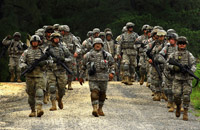The need to serve
by jchurch | October 9, 2011 10:44 am
By JOHN CHURCH
Shaking off the shock of the attacks of Sept. 11, 2001 the people of the United States felt the need to act. That cataclysmic day was similar to other major disasters; Americans rolled up their sleeves to give blood, walked into military recruiting offices to give their time, and possibly their lives, and opened their wallets to give cash in reaction to the nightmare in Manhattan, Washington D.C. and an open field in Pennsylvania.
Military service
Having seen the attack in person or on TV many Americans correctly assumed we would soon strike back against the terrorist organization that planned the assault. Duty called and they walked into a military recruiting office to sign up.
 [1]
[1]Soldiers of the Army National Guard conduct fire team movement techniques during mobilization training at Fort Dix. (U.S. Army Staff Sgt. Russell Lee Klika)
“Pre 9/11 we struggled to maintain 90 percent strength, and that’s what we consider the successful level of manning,” said Robert Schofield then a Lt. Colonel commanding the 3rd Battalion, 112 Field Artillery of the New Jersey Army National Guard. “After 9/11 we spiked. We had the opposite problem of not having enough positions to support the volunteers.”
[AUDIO: Listen to Robert Schofield explain what happened.]
Schofield, now a civilian working for the Guard, explained that the Guard has a dual status mission, responding to state domestic emergencies as the military first responder, supported by the active duty military if additional resources are needed. The federal wartime mission is the opposite, with the guard supporting the federal military.
“We definitely had a surge,” said Schofield of Ewing. N.J. “It gave us an opportunity to be more selective than we otherwise would be. In fact over the years the entry requirements on the active duty side and the reserve components, including the National Guard, have gotten higher.
When asked how long the surge in interest in the guard took to build, he stressed it was immediate.
“There were people who probably walked into recruiting offices on September 11,” Schofield said. Even with higher initial entry requirements the New Jersey Army National Guard is still over their manning level ten years later. “We have been at the 102 percent level, +/- 1.5 percent for the last several years.”
The surge in enlistment was not limited to the New Jersey Army National Guard.
“The Air [Force National] Guard is pretty much the same story as us,” said Schofield. “They were brought into the war a lot faster than the Army was. They run at 104 percent manning level. Before 9/11 they probably hovered around 100 percent. They attract more people because they have a sexier mission. They fly planes we drive trucks.”
Red Cross
As an alternate to military service, residents of northwest N.J. donated their time as civilians with the American Red Cross[2].
“This chapter is much, much bigger,” said Sherry Clain of Hamburg, disaster services county supervisor for the Sussex County branch of the American Red Cross. “In 2001 we had maybe 50 volunteers. Now we have 135 trained volunteers. Volunteers come and go but we have a good steady core of people.”
“After any disaster we get an influx of volunteers,” said Kaitlyn Bessemer of Freedon, Volunteer Manager of the Sussex and Warren County chapter of the American Red Cross. Volunteers attend training before serving. The classes are normally held for a few hours at a time over the course of several weeks.
“Many times after a disaster we plan mass trainings,” said Bessemer. “The training sessions can be completed over one weekend.”
The surge of volunteers does not disappear when a particular disaster has passed.
“Many volunteers are still with us.”
Red Cross chapters surrounding Manhattan did not rush in with volunteers.
“The Red Cross is not a first responder,” said Clain. The organization is geared toward support – food, shelter, etc. – rather than rescue or first aid functions.
Toys for Tots
Lacking the time, or separated by distance from the 9/11 attack areas, some Americans decided to volunteer monetarily. A General Accounting Office report [3]pointed out that coordination between charities may increase donations in future disasters. Despite this weakness, the top 35 charities supporting the victims of 9/11 collected $2.6 trillion. Initially the donations were made to charities supporting the victims of the attacks.
 [4]
[4]Toys for Tots pickup. We ended up with 181 bicycles and about 30 barrels-worth of toys. WSI Nevada Team stepped up to help this year, donating $1500, as well as toys and bicycles. Creative Commons
“After 9/11 we got less contributions,” said Major Bill Grein USMC (ret.), vice president of the Toys for Tots [5]Foundation, a program run by the United States Marine Corps Reserve which donates toys to children whose parents cannot afford to buy them gifts for Christmas. “Contributions were down because people contributed to causes more directly focused on 9/11.”
Grein joked about developing an ulcer starting in the fall every year.“Donations dropped in September and October but rebounded after Thanksgiving.”
Quoting corporate donation figures, Grein explained that donations have generally grown over the last decade despite the downturn of the economy.
“Corporate donations totaled $35 million in 2001 compared to $30 million in 2000,” said Grein.
He pointed out the wide variations in the yearly totals, the source of his annual ulcer.
“The peak of donations was in 2009 with $47 million but it dropped to $35 million in 2010,” said Grein.
He is expecting a surge in donations after Thanksgiving.
- [Image]: https://integritas.ramaporecord.org/?attachment_id=1553
- American Red Cross: http://www.redcross.org/
- report : http://www.investigativeproject.org/documents/testimony/217.pdf
- [Image]: https://integritas.ramaporecord.org/?attachment_id=1554
- Toys for Tots : http://www.toysfortots.org/
Source URL: https://integritas.ramaporecord.org/?p=1325